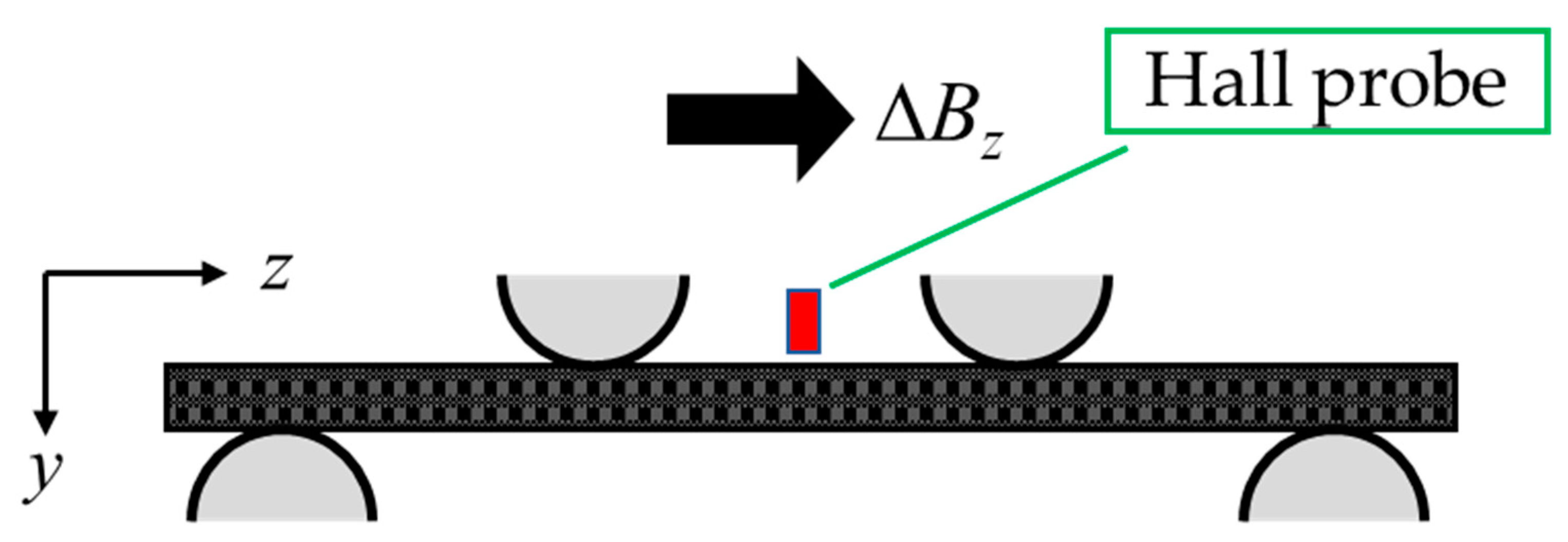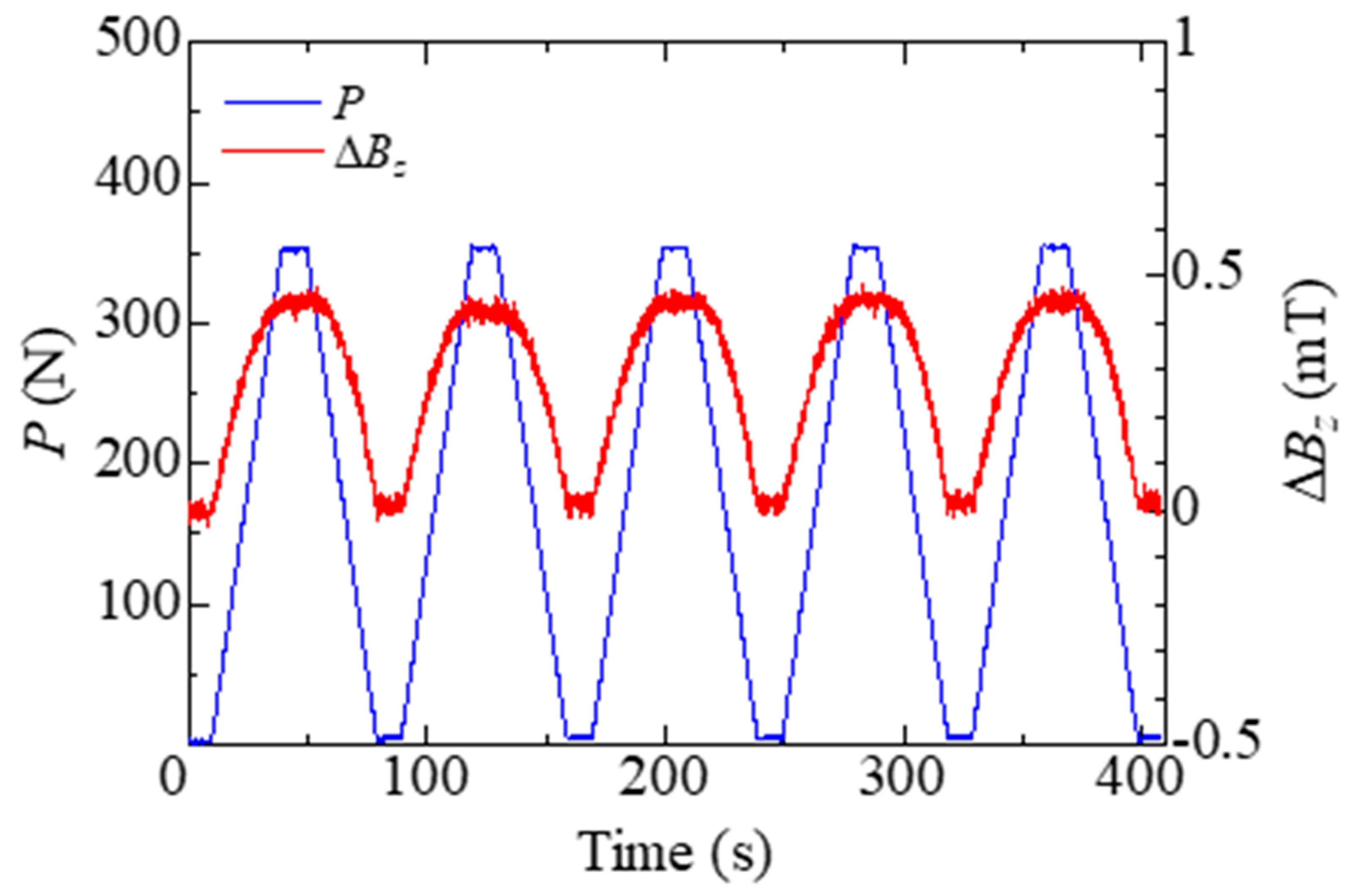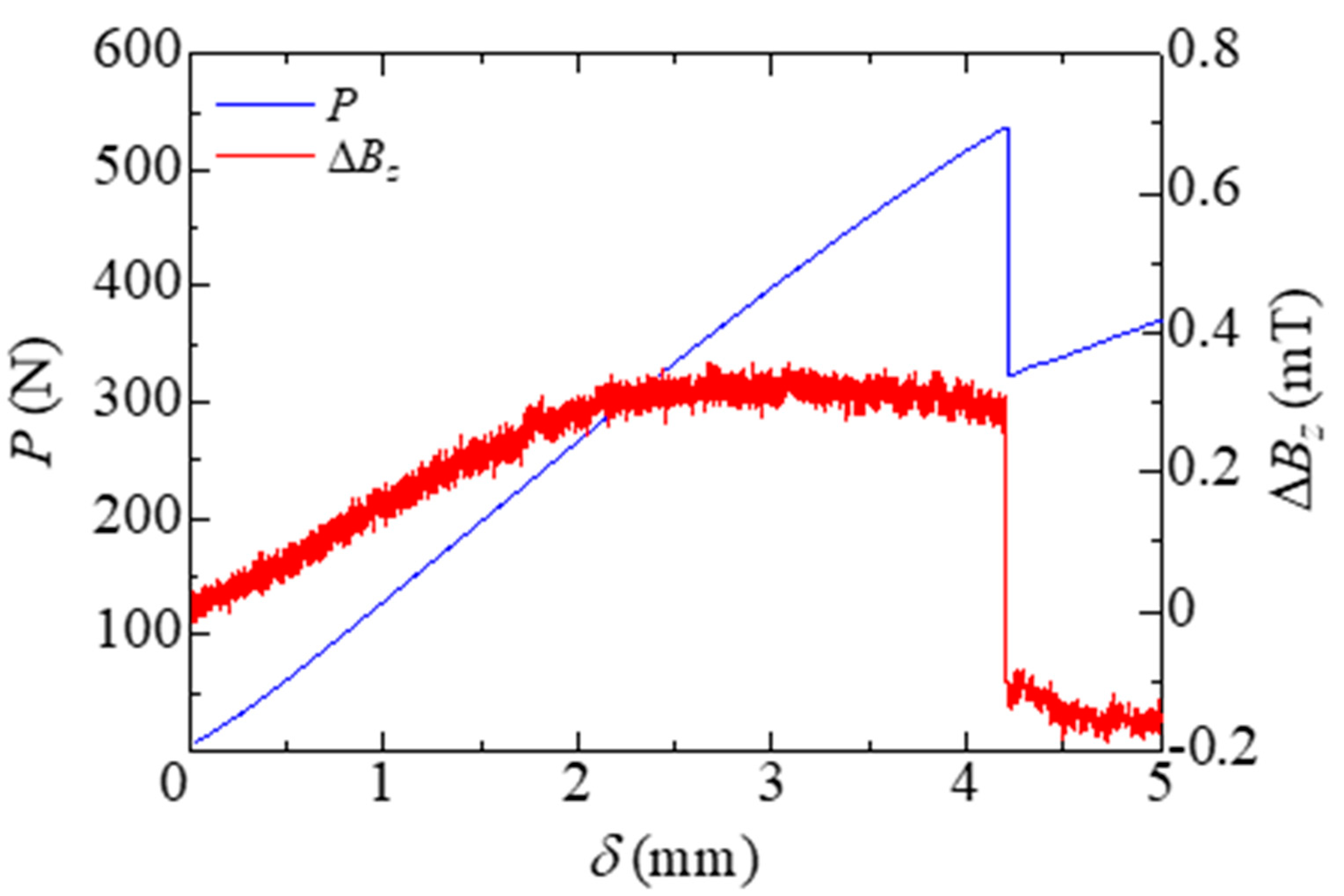Fabrication and Characterization of Carbon Fiber Reinforced Plastics Containing Magnetostrictive Fe-Co Fibers with Damage Self-Detection Capability
Abstract
:1. Introduction
2. Experimental Procedure
3. Results and Discussion
4. Conclusions
Author Contributions
Funding
Acknowledgments
Conflicts of Interest
References
- Mitra, M.; Gopalakrishnan, S. Guided wave based structural health monitoring: A review. Smart Mater. Struct. 2016, 25. [Google Scholar] [CrossRef]
- Hwang, M.; Kang, L. Characteristics and fabrication of piezoelectric GFRP using smart resin prepreg for detecting impact signals. Compos. Sci. Technol. 2018, 167, 224–233. [Google Scholar] [CrossRef]
- Santoni-Bottai, G.; Giurgiutiu, V. Damage detection at cryogenic temperatures in composites using piezoelectric wafer active sensors. Struct. Health Monit. Int. J. 2012, 11, 510–525. [Google Scholar] [CrossRef]
- Narita, F.; Katabira, K. Stress-Rate Dependent Output Voltage for Fe29Co71 Magnetostrictive Fiber/Polymer Composites: Fabrication, Experimental Observation and Theoretical Prediction. Mater. Trans. 2017, 58, 302–304. [Google Scholar] [CrossRef]
- Lu, X.; Li, H. Magnetic properties of Terfenol-D film on a compliant substrate. J. Magn. Magn. Mater. 2010, 322, 2113–2116. [Google Scholar] [CrossRef]
- Calkins, F.; Flatau, A.; Dapin, M. Overview of magnetostrictive sensor technology. J. Intell. Mater. Syst. Struct. 2007, 18, 1057–1066. [Google Scholar] [CrossRef]
- Hein, M.; Park, J.; Cozzo, J.A.; Flatau, A.; Stadler, B.J.H. Electrodeposited Fe-Ga Alloy Films for Directly Coupled Noncontact Torque Sensing. IEEE Sens. J. 2019, 19, 6655–6661. [Google Scholar] [CrossRef]
- Li, J.; Li, M.; Mu, X.; Bao, X.; Gao, X. Magnetostrictive Fe-Ga Wires for Application in the High-Temperature Waveguide Device. Mater. Trans. 2018, 59, 679–684. [Google Scholar] [CrossRef]
- Yoo, B.; Na, S.-M.; Pines, D.J. Influence of particle size and filling factor of Galfenol flakes on sensing performance of magnetostrictive composite transducers. IEEE Trans. Magn. 2015, 51, 2503204. [Google Scholar] [CrossRef]
- Yoffe, A.; Shilo, D. The magneto-mechanical response of magnetostrictive composites for stress sensing applications. Smart Mater. Struct. 2017, 26, 065007. [Google Scholar] [CrossRef]
- Adelsberg, N.; Weber, Y.; Yoffe, A.; Shilo, D. Wireless thin layer force sensor based on a magnetostrictive composite material. Smart Mater. Struct. 2017, 26, 065013. [Google Scholar] [CrossRef]
- Yamazaki, T.; Yamamoto, T.; Furuya, Y.; Nakao, W. Magnetic and magnetostrictive properties in heat-treated Fe-Co wire for smart material/device. Mech. Eng. J. 2018, 5. [Google Scholar] [CrossRef]
- Yamazaki, T.; Furuya, Y.; Nakao, W. Experimental evaluation of domain wall dynamics by Barkhausen noise analysis in Fe30Co70 magnetostrictive alloy wire. J. Magn. Magn. Mater. 2019, 475, 240–248. [Google Scholar] [CrossRef]
- Narita, F. Inverse Magnetostrictive Effect in Fe29Co71 Wire/Polymer Composites. Adv. Eng. Mater. 2017, 19. [Google Scholar] [CrossRef]
- Katabira, K.; Yoshida, Y.; Masuda, A.; Watanabe, A.; Narita, F. Fabrication of Fe-Co Magnetostrictive Fiber Reinforced Plastic Composites and Their Sensor Performance Evaluation. Materials 2018, 11, 406. [Google Scholar] [CrossRef] [PubMed]
- Huang, H.; Yang, C.; Wu, Z. Electrical sensing properties of carbon fiber reinforced plastic strips for detecting low-level strains. Smart Mater. Struct. 2012, 21. [Google Scholar] [CrossRef]
- Takeda, T.; Narita, F. Fracture behavior and crack sensing capability of bonded carbon fiber composite joints with carbon nanotube-based polymer adhesive layer under Mode I loading. Compos. Sci. Technol. 2017, 146, 26–33. [Google Scholar] [CrossRef]
- Narita, F.; Nagaoka, H.; Wang, Z. Fabrication and impact output voltage characteristics of carbon fiber reinforced polymer composites with lead-free piezoelectric nano-particles. Mater. Lett. 2019, 236, 487–490. [Google Scholar] [CrossRef]
- Kubicka, M.; Mahrholz, T.; Kühn, A.; Wierach, P.; Sinapius, M. Magnetostrictive properties of epoxy resins modified with Terfenol-D particles for detection of internal stress in CFRP. Part 1: Materials and processes. J. Mater. Sci. 2012, 47, 5752–5759. [Google Scholar] [CrossRef]
- Kubicka, M.; Mahrholz, T.; Kühn, A.; Wierach, P.; Sinapius, M. Magnetostrictive properties of epoxy resins modified with Terfenol-D particles for detection of internal stress in CFRP. Part 2: evaluation of stress detection. J. Mater. Sci. 2013, 48, 6578–6584. [Google Scholar] [CrossRef]






© 2019 by the authors. Licensee MDPI, Basel, Switzerland. This article is an open access article distributed under the terms and conditions of the Creative Commons Attribution (CC BY) license (http://creativecommons.org/licenses/by/4.0/).
Share and Cite
Katabira, K.; Kurita, H.; Yoshida, Y.; Narita, F. Fabrication and Characterization of Carbon Fiber Reinforced Plastics Containing Magnetostrictive Fe-Co Fibers with Damage Self-Detection Capability. Sensors 2019, 19, 4984. https://doi.org/10.3390/s19224984
Katabira K, Kurita H, Yoshida Y, Narita F. Fabrication and Characterization of Carbon Fiber Reinforced Plastics Containing Magnetostrictive Fe-Co Fibers with Damage Self-Detection Capability. Sensors. 2019; 19(22):4984. https://doi.org/10.3390/s19224984
Chicago/Turabian StyleKatabira, Kenichi, Hiroki Kurita, Yu Yoshida, and Fumio Narita. 2019. "Fabrication and Characterization of Carbon Fiber Reinforced Plastics Containing Magnetostrictive Fe-Co Fibers with Damage Self-Detection Capability" Sensors 19, no. 22: 4984. https://doi.org/10.3390/s19224984
APA StyleKatabira, K., Kurita, H., Yoshida, Y., & Narita, F. (2019). Fabrication and Characterization of Carbon Fiber Reinforced Plastics Containing Magnetostrictive Fe-Co Fibers with Damage Self-Detection Capability. Sensors, 19(22), 4984. https://doi.org/10.3390/s19224984






